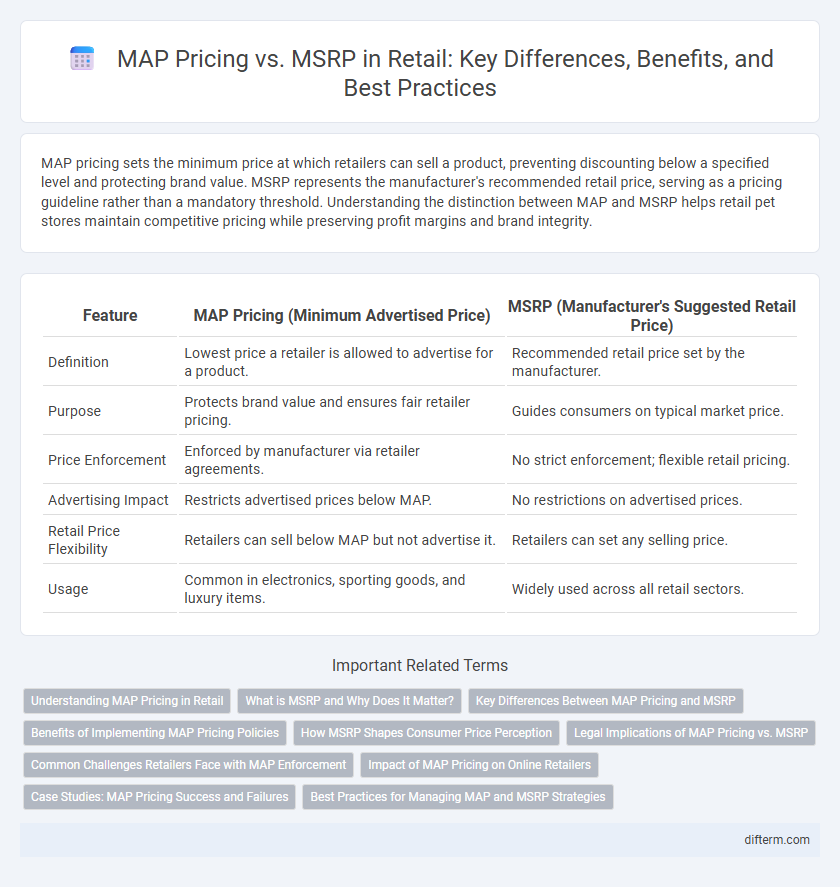MAP pricing sets the minimum price at which retailers can sell a product, preventing discounting below a specified level and protecting brand value. MSRP represents the manufacturer's recommended retail price, serving as a pricing guideline rather than a mandatory threshold. Understanding the distinction between MAP and MSRP helps retail pet stores maintain competitive pricing while preserving profit margins and brand integrity.
Table of Comparison
| Feature | MAP Pricing (Minimum Advertised Price) | MSRP (Manufacturer's Suggested Retail Price) |
|---|---|---|
| Definition | Lowest price a retailer is allowed to advertise for a product. | Recommended retail price set by the manufacturer. |
| Purpose | Protects brand value and ensures fair retailer pricing. | Guides consumers on typical market price. |
| Price Enforcement | Enforced by manufacturer via retailer agreements. | No strict enforcement; flexible retail pricing. |
| Advertising Impact | Restricts advertised prices below MAP. | No restrictions on advertised prices. |
| Retail Price Flexibility | Retailers can sell below MAP but not advertise it. | Retailers can set any selling price. |
| Usage | Common in electronics, sporting goods, and luxury items. | Widely used across all retail sectors. |
Understanding MAP Pricing in Retail
MAP pricing in retail refers to the Minimum Advertised Price set by manufacturers to prevent retailers from advertising products below a specified threshold, preserving brand value and market stability. Unlike MSRP (Manufacturer's Suggested Retail Price), which is a recommended selling price, MAP strictly controls advertised prices without restricting the actual selling price. Understanding MAP pricing helps retailers maintain competitive parity while avoiding penalties or supply restrictions from manufacturers.
What is MSRP and Why Does It Matter?
MSRP, or Manufacturer's Suggested Retail Price, is the price point recommended by the product's manufacturer to standardize retail pricing and maintain brand value. It matters because it sets customer expectations and helps retailers position products competitively while avoiding price wars. Understanding MSRP enables retailers to balance profitability with market demand and ensures consistency across different sales channels.
Key Differences Between MAP Pricing and MSRP
MAP pricing, or Minimum Advertised Price, dictates the lowest price at which retailers can publicly advertise a product, ensuring brand value and preventing undercutting in promotions. MSRP, or Manufacturer's Suggested Retail Price, is a recommended selling price set by manufacturers to standardize pricing across various retail channels but does not legally restrict actual sale prices. The core difference lies in enforceability: MAP controls advertised prices to protect market positioning, while MSRP serves as a pricing guideline without binding compliance.
Benefits of Implementing MAP Pricing Policies
Implementing Minimum Advertised Pricing (MAP) policies helps retailers maintain consistent brand value by preventing price erosion and preserving profit margins across sales channels. MAP pricing ensures fair competition among resellers, fostering long-term partnerships and customer trust. This policy also protects the manufacturer's image by controlling public price messaging, supporting premium product positioning in the retail market.
How MSRP Shapes Consumer Price Perception
MSRP (Manufacturer's Suggested Retail Price) significantly shapes consumer price perception by establishing a benchmark for product value and quality expectations. Shoppers often equate MSRP with the product's true worth, affecting their willingness to pay and perceived deal attractiveness when seeing prices below MSRP. This psychological anchor influences purchase decisions more than MAP (Minimum Advertised Price) policies, which primarily regulate retailer pricing visibility rather than direct consumer perception.
Legal Implications of MAP Pricing vs. MSRP
Minimum Advertised Price (MAP) policies legally prevent retailers from advertising products below a set price, protecting brand value without fixing actual selling prices, which preserves compliance with antitrust laws. Manufacturer's Suggested Retail Price (MSRP) is a recommended price that retailers may choose to follow or disregard, offering guidance without legal enforcement. Violations of MAP policies can lead to penalties like termination of supply agreements, while disregarding MSRP carries no direct legal consequences but may affect manufacturer-retailer relationships.
Common Challenges Retailers Face with MAP Enforcement
Retailers frequently encounter challenges enforcing Minimum Advertised Price (MAP) policies due to inconsistent compliance among resellers and limited legal recourse, which can undermine brand value and profit margins. The discrepancy between MAP and Manufacturer's Suggested Retail Price (MSRP) complicates pricing strategies, as MAP sets a floor for advertised prices while MSRP serves as a recommendation, creating confusion in enforcement and consumer perception. Effective MAP enforcement requires robust monitoring tools and collaboration with manufacturers to address unauthorized discounting and maintain competitive pricing integrity.
Impact of MAP Pricing on Online Retailers
MAP pricing enforces minimum advertised price limits that protect brand value by preventing price undercutting among online retailers. It helps maintain consistent profit margins and reduces price wars, fostering fair competition in the digital marketplace. Retailers adhering to MAP policies benefit from stabilized pricing strategies that enhance consumer trust and preserve product perception.
Case Studies: MAP Pricing Success and Failures
Case studies in retail reveal that MAP pricing often drives higher retailer margins and consistent brand value, as seen in consumer electronics where strict enforcement prevented price wars and preserved product prestige. Conversely, failures in MAP pricing emerge when enforcement lapses or unauthorized sellers undercut prices, leading to brand dilution and lost revenue, as demonstrated by certain apparel brands struggling with online discounting. These examples highlight the critical balance retailers must strike between MAP pricing policies and real-world compliance to optimize market positioning.
Best Practices for Managing MAP and MSRP Strategies
Effective management of Minimum Advertised Price (MAP) and Manufacturer's Suggested Retail Price (MSRP) requires clear communication of pricing policies to all retail partners and monitoring compliance through automated price tracking tools. Retailers should leverage data analytics to assess market conditions and competitor pricing, ensuring MAP enforcement protects brand value without alienating resellers. Implementing flexible pricing strategies that balance the need for competitive discounts with adherence to MSRP helps maintain profit margins and enhances customer trust.
MAP Pricing vs MSRP Infographic

 difterm.com
difterm.com